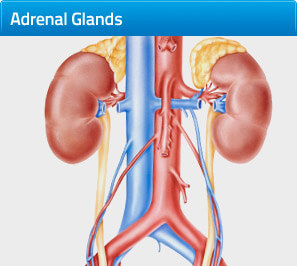FAQ Adrenal Fatigue
What is adrenal fatigue?
Adrenal fatigue is a condition in which the adrenal glands through chronic stress are unable to meet your body’s demands for cortisol production.
What are the adrenal glands?
The two adrenal glands, which derive their name from their location in the body, are key players in your body’s response to stress. Situated on top of the kidneys, these pyramid-shaped organs, the size of walnuts, are actually two endocrine glands in one: an inner medulla, which orchestrates your short-term stress response and the release of adrenaline, and an outer cortex, which mediates your adaptation to chronic stress and produces cortisol.
What are the symptoms of adrenal fatigue?
Adrenal Fatigue can cause a host of health problems:
- Allergies and/or asthma
- Irregular menstrual cycles
- Infertility
- Low libido
- Anxiety or panic attacks
- Headaches
- Heart palpitations
- Depression
- Hair loss
- Chronic fatigue
- Muscle and joint pain
- Difficulty “bouncing back” from stress
- Dizziness or lightheadedness upon standing
- Severe fatigue – the #1 symptom of adrenal insufficiency
- Cold and heat intolerance
- Recurrent infections
- Hypoglycemia (low blood sugar)
- Hypotension (low blood pressure)
With adrenal fatigue, you are likely to be more vulnerable to infections and to heal more slowly than those with healthy adrenal glands.
What is the cause of adrenal fatigue?
Chronic, unrelenting stress, whether physical or psychological or both, eventually leads to adrenal fatigue. The adrenals simply cannot produce enough cortisol to meet the demands. The result? We feel “stressed out” – because we are. As we age, our adrenal glands produce less cortisol. This inevitably leads to adrenal fatigue to one degree or another.
What is cortisol’s function in the body and where is it produced?
Cortisol is essential to life. It is produced by the adrenal glands, which are situated on top of the kidneys. These pyramid-shaped organs, the size of walnuts, are actually two endocrine glands in one.
Cortisol is both a natural antihistamine and a natural anti-inflammatory. The primary function of cortisol is to promote gluconeogenesis, the conversion of fats and proteins to sugar (glucose). Gluconeogenesis is an essential component of your body’s adaptation to chronic stress, ensuring that your vital organs, especially your brain, heart, and skeletal muscles, have enough energy to meet the increasing workload. Cortisol also decreases inflammation.
Low-dose cortisol can make a tremendous difference in the energy and well-being of patients with hypothyroidism. Not only does it improve your energy, raise your body temperature, and increase your resistance to infection, it also helps your body utilize thyroid hormone. Natural cortisol is especially helpful for patients with autoimmune thyroiditis, an extremely common cause of hypothyroidism. Like other autoimmune conditions, autoimmune thyroiditis can develop when your adrenal glands are stressed, especially following pregnancy or at menopause.
Natural cortisol actually reduces the levels of thyroid antibodies, enhancing the effectiveness of thyroid hormone. The stressful lifestyles that we lead in today’s fast-paced world, regardless of gender, can make any of us more susceptible to adrenal fatigue.
Is there a correlation between hypothyroidism and adrenal fatigue?
Adrenal fatigue often occurs in conjunction with hypothyroidism. They may lead to many of the same symptoms. Although they are clinically distinct conditions, adrenal insufficiency and hypothyroidism are both metabolic problems that result in a slowdown of your body’s functions and a decline in energy. Some people only have one of these conditions, but many people have both.
In the absence of adequate cortisol, thyroid hormone replacement is less effective. When the adrenal glands are weak, even normal thyroid activity is a burden. Adding supplemental thyroid hormone may result in an initial improvement in your energy level and other symptoms, but as the adrenal glands become more exhausted, energy production is shut down. The solution is not more thyroid hormone. What is called for is adrenal support with small doses of cortisol.
Low-dose cortisol can make a tremendous difference in the energy and well-being of patients with hypothyroidism. Not only does it improve energy, raise body temperature, and increase resistance to infection, it also helps the body utilize thyroid hormone. Natural cortisol is especially helpful for patients with autoimmune thyroiditis, an extremely common cause of hypothyroidism. Like other autoimmune conditions, autoimmune thyroiditis can develop when your adrenal glands are stressed, especially following pregnancy or at menopause. Natural cortisol actually reduces levels of thyroid antibodies, enhancing the effectiveness of thyroid hormone.
Can estrogen dominance contribute to adrenal fatigue?
Adrenal fatigue affects women much more frequently than men. High levels of estrogen cause a corresponding increase in levels of cortisol-binding globulin. Like other hormone-binding globulins, cortisol-binding globulin interferes with hormone function. It circulates in the bloodstream and as its name suggests, binds to cortisol, and renders it inactive. A woman with estrogen dominance may have adequate levels of total cortisol in her bloodstream, but her free, available cortisol level may be very low. Only free cortisol can pass through cell membranes and activate receptors inside the cell.
Excess estrogen impairs adrenal function in another way: it interferes with the release of cortisol from the adrenal cortex. In laboratory animals, when estrogen levels are high, the adrenal cortex fails to respond to signals from the brain. In other words, even though the brain is emitting a cry of alarm – “Send more cortisol!” – the gland responsible for meeting this demand does not “receive” it.
Does adrenal insufficiency contribute to estrogen dominance?
Just as estrogen dominance can contribute to adrenal insufficiency, adrenal insufficiency can contribute to estrogen dominance. Cortisol is made in the adrenal cortex from progesterone. If your progesterone levels are low, then your cortisol levels are likely to be low as well. Because the body considers cortisol more important to survival than progesterone, whatever progesterone is available in the adrenal cortex is going to be converted into cortisol. When a woman's ovaries are producing less progesterone, her adrenal glands will not produce adequate amounts of cortisol.
Is there a connection between adrenal fatigue and allergies?
Adrenal fatigue is a common underlying problem in patients with allergies, especially when these allergies have been poorly managed. Out-of-control allergies often lead to recurrent sinus infections, which lead to repeated courses of antibiotic therapy, which lead to yeast overgrowth and impaired immunity. This cycle of infection, antibiotic treatment, impaired immunity, and reinfection adds stress to the body, weakening the adrenals, and reducing cortisol levels.
This in turn worsens allergies, because cortisol is the body’s anti-allergy hormone of choice. Cortisol is both a natural antihistamine and a natural anti-inflammatory. Prednisone, dexamethasone, and other high-dose synthetic corticosteroids that are used to alleviate the inflammation of bronchial asthma, rheumatoid arthritis, and other autoimmune conditions are simply the drug companies’ alternate versions of the body’s own natural anti-inflammatory hormone, cortisol.
Patients with long-standing, unmanaged allergies are usually suffering from adrenal fatigue. The addition of cortisol to their treatment regimen lessens the likelihood of recurrent sinus infections and helps them regain energy more quickly.
Does adrenal fatigue cause hypoglycemia (low blood sugar)?
Suboptimal cortisol levels can cause hypoglycemia, or low blood sugar. Remember, the primary function of cortisol is to promote gluconeogenesis, the conversion of fats and proteins to sugar (glucose).
Is there a natural solution for adrenal fatigue? How do you diagnose adrenal fatigue?
Your clinical history is the best indicator of adrenal function.
The natural solution for adrenal fatigue is the use of physiologic, subreplacement doses of bioidentical cortisol. A young, healthy person produces 20-30 mg of cortisol per day. Our starting dose of slow-release biologically identical cortisol is a fraction of that per day and is adjusted incrementally as symptoms warrant.
Along with this, we also recommend DHEA, another hormone produced by the adrenal glands. The amount of DHEA produced by the adrenal cortex is greater than that of any of the other adrenal hormones, including the androgens (androstenedione and testosterone) and the estrogens (estradiol, estrone, and estriol).
Nutritional supplements are also vital. There is one nutrient in particular that is crucial to healthy adrenal glands: vitamin C. The adrenal cortex has the highest concentration of vitamin C of all the organs in your body and the cells of this gland use it at a higher rate than any other cells. Vitamin C enhances immunity, which is often impaired in those with adrenal insufficiency. During times of stress, our bodies excrete vitamin C more rapidly, making our need for this vitamin even greater. All of our adult patients are advised to supplement with 3,000 – 6,000 mg of vitamin C per day. A slow-release, buffered form is best to prevent overacidity of the stomach and to ensure sustained blood levels throughout the day.
What is the difference between bioidentical cortisol and synthetic corticosteroids produced by drug companies?
Bioidentical cortisol is biologically identical to the naturally occurring cortisol produced by your body. Corticosteroids are medications that mimic the effect of cortisol, such as cortisone and prednisone. Very high pharmacologic doses (50-300mg/day) of synthetic corticosteroids such as Prednisone have severe adverse effects because they mimic an overproduction of cortisol by the adrenal glands. Some of these adverse effects include:

- High blood pressure
- Weight gain
- Mood swings
- Cataracts
- High blood sugar
- Increased risk of infections
- Menstrual irregularities
- Acne
- Depression
- Rapid weight gain
- Pancreatitis
- Dry skin
- Shortness of breath
- Chest pain
- Glaucoma (elevated blood pressure in the eyes)
- Suppressed adrenal gland hormone production
- Thin skin that easily bruises and heals slowly
- Deposits of fat in the upper back, stomach, chest and face
Corticosteroids cause levels of vitamin B6 and folic acid to decline. Even more serious, these drugs can increase the risk of osteoporosis because they deplete the body of vitamin D and interfere with calcium absorption. Physiologic replacement doses of the naturally occurring bioidentical cortisol produced by the body, however, safely reestablish the body’s optimal levels of cortisol.








